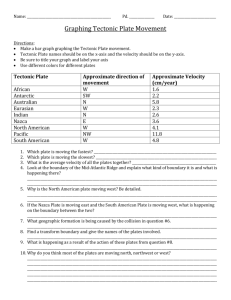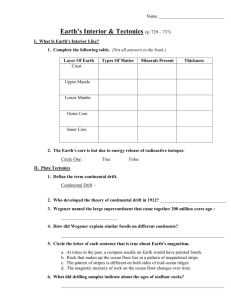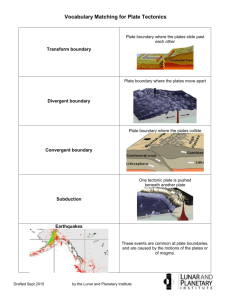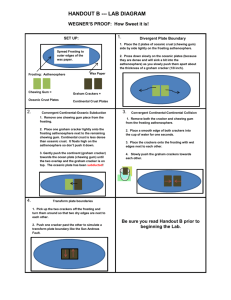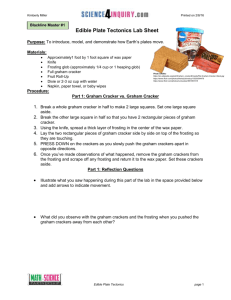Data Sheet for Handout B with answers
advertisement
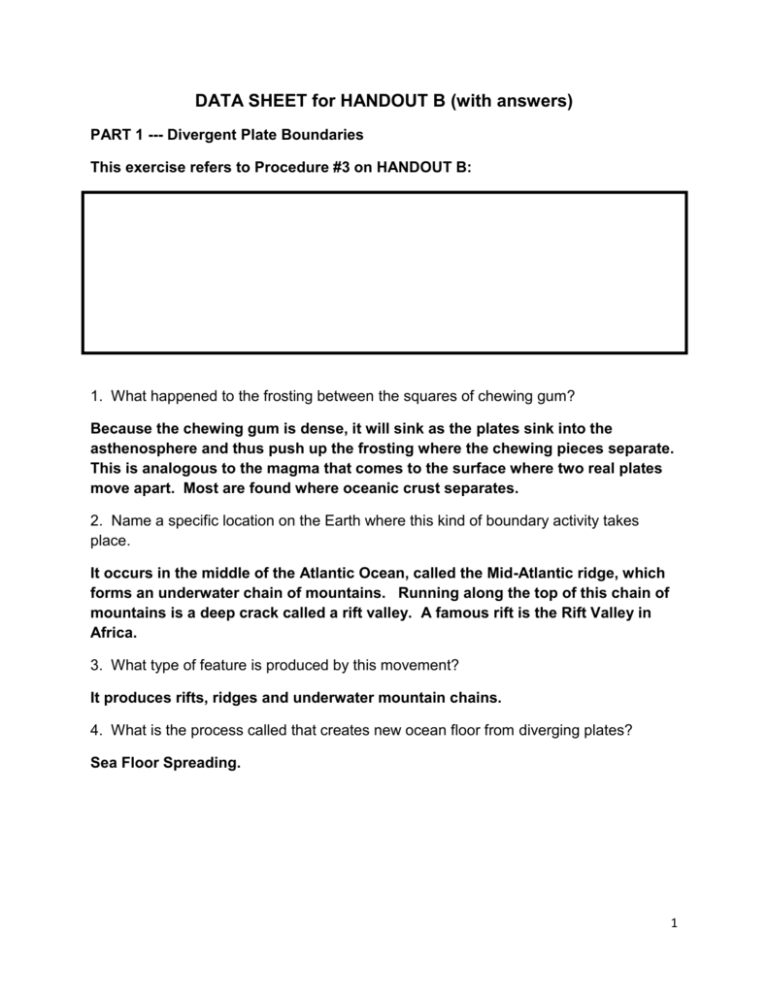
DATA SHEET for HANDOUT B (with answers) PART 1 --- Divergent Plate Boundaries This exercise refers to Procedure #3 on HANDOUT B: 1. What happened to the frosting between the squares of chewing gum? Because the chewing gum is dense, it will sink as the plates sink into the asthenosphere and thus push up the frosting where the chewing pieces separate. This is analogous to the magma that comes to the surface where two real plates move apart. Most are found where oceanic crust separates. 2. Name a specific location on the Earth where this kind of boundary activity takes place. It occurs in the middle of the Atlantic Ocean, called the Mid-Atlantic ridge, which forms an underwater chain of mountains. Running along the top of this chain of mountains is a deep crack called a rift valley. A famous rift is the Rift Valley in Africa. 3. What type of feature is produced by this movement? It produces rifts, ridges and underwater mountain chains. 4. What is the process called that creates new ocean floor from diverging plates? Sea Floor Spreading. 1 PART 2 --- Convergent Plate Boundaries (Continental and Oceanic) This exercise refers to Procedure #4 on HANDOUT B: 1. What happens when a tectonic plate gets subducted? The lighter less dense plate goes over the top; the colder denser plate bends and slides under and plunges deeper into the mantle. 2. Name a specific location on Earth where this kind of boundary activity takes place. Andes Mountains in South America and the Cascade Mountains of the Pacific Northwest. 3. What features are formed on the continent along this boundary? It melts the mantle and creates volcanos. 4. What feature is formed in the ocean along the subduction zone? Deep oceanic trenches erupt to form volcanic mountains or chains of volcanic islands. An example are the Mariana Islands. 2 PART 3 --- Convergent Plate Boundaries (Continental) This exercise refers to Procedure #5 on HANDOUT B: 1. What happens to the wet ends of the graham crackers? They crumble and buckle up which shows how mountain ranges form when continents collide and rocks are pushed up. 2. In what way do the wet crackers act more like the real crustal plates than the dry crackers? The dry crackers would just crumble and not be pushed up. The wet edges push up similar to the rocks. 3. What feature do the resulting ends of the wet crackers represent? They represent the rocks buckling and moving up and not just crumbling apart. 4. Name a specific location on the Earth where this type of boundary activity takes place? The Alps, the Appalachians, the Himalayas which are still forming. Not the Rockies because they formed by glaciers. 3 PART 4 --- LATERAL (TRANSFORM) PLATE BOUNDARIES (Continental) This exercise refers to Procedure #6 on HANDOUT B: 1. Why is this movement often described as “horizontal” sliding? Two plates are moving side by side, each moving in opposite directions. 2. Name a specific location on the Earth where this type of boundary activity takes place. At San Andreas, California. 3. Nothing happens at the beginning, but as the pressure is increased, the crackers finally break. What do we call the breaking and vibrating of the Earth’s crust? An earthquake. CONCLUSION: 1. Give an example of how plate movement directly affects the construction of Earth’s surface. If one plate is denser and heavier than the other, it will subduct which means it will slide beneath the other plate. This can build up a mountain such as Washington’s Cascade mountains. 2. Give an example of how plate movement directly causes the destruction of Earth’s surface. Volcanoes and earthquakes can cause massive destruction such as the damage done in San Francisco, CA and Christchurch, Australia. 4 3. What are two strengths for using Graham Crackers, chewing gum and frosting for a model for understanding how plates move and the theory of Plate Tectonics? Visualize what happens in the events in simplified way because it is smaller and more easily seen. It simulates the “real” thing. Models can be mathematical (drawn to scale). 4. What are the two weaknesses of using these as a model for understanding plate movement and the theory of Plate Tectonics? Components used in the model are different from components from the actual object being modeled. All conditions of using the model are not realistic compared to the conditions of the real world. CLEAN UP!!! 5

